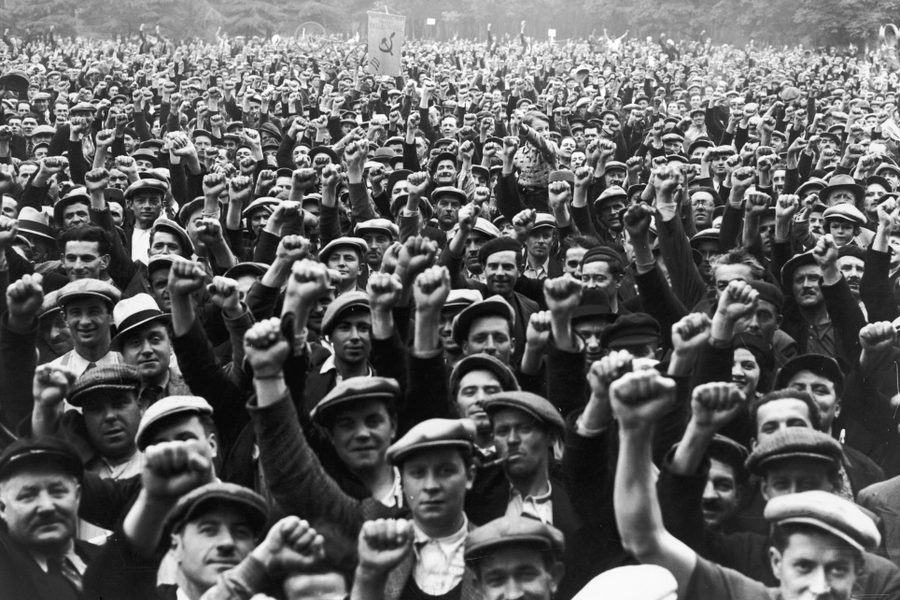
You know that things are getting serious when #GeneralStrike starts trending on Twitter. It happened last week, when Donald Trump was publicly mulling the idea of sending Americans back to work by Easter, a move that would imperil countless lives. A general strike has long held a strong utopian allure. But what would it take to actually pull one off? We spoke to the experts about the reality behind the dream.
Amid a healthcare crisis intertwined with an economic crisis, with millions of people freshly unemployed and new wildcat strikes and work stoppages popping off daily, we are living through the most opportune environment for massive, radical labor actions in many decades. America has had great crises before, though — and it has never had a true, nationwide general strike.
Is it even possible?
The “general strikes” in American history have been confined to individual cities. The most famous was probably the Seattle general strike of 1919, when more than 60,000 (peaceful) striking union members induced a total shutdown of the city’s business. Periods of intense social upheaval sparked other citywide general strikes — most notably in 1934 in San Francisco, during the Great Depression, and in Oakland in 1946, just after World War Two. Joshua Freeman, a labor history professor at the City University of New York, notes that those successful strikes depended on the combination of established labor union coalitions and “a broad class anger, usually at what was seen as an attack by business or police on legitimate working-class activity.” A general strike today would probably require the same combination. And while the union establishment of 2020 is in some ways weaker than it was a century ago, the teachers’ strikes and other mass labor actions of recent years show how quickly that can change.
“That is a very tall order, and at the moment it seems to me quite unlikely,” Freeman says, “but we are living in a moment of hyperspeed change. So who knows.”
Who knows?
Saturate them with urgency
The general strike was catapulted into public consciousness as a legitimate possibility early last year, when flight attendant union leader Sara Nelson gave a speech (that went viral) calling on fellow union leaders to consider it as a way to end the ongoing government shutdown. Today, Nelson still believes a general strike should not be considered an impossibility. “Any labor leaders should be able to talk about this,” she says. “A general strike may seem overwhelming, but it has the same fundamentals as preparing for any strike.”
That means “you have to saturate the thinking of the general public” with the importance of the situation, says Nelson. In normal times that is incredibly difficult, in a nation as big as ours; but right now, the public’s thinking is already focused on the physical, economic, and moral dangers of this crisis. If a necessary condition is, as Nelson says, a widespread sense of urgency so intense that it feels “like if you don’t take action right now, you’re gonna die,” we’re in luck — millions of Americans are having that very thought already.
Like Freeman, Nelson believes any successful general strike would have to be powered at its core by unions. Not only do they have the expertise and infrastructure necessary for the large-scale communications, strategy, and logistical needs of such an undertaking, but they also have a key characteristic that other groups don’t: They are broad-based organizations of all types of working people — all races, locations, and political affiliations, united by their identity as workers — rather than affinity groups that include certain demographics, but exclude others. That is vital, when it comes to pulling off something that cuts across the lines that normally divide American society. “You can’t rely on self-selecting organizations to run something like this, because there are people who are going to feel that they’re not included,” she says.
Consider the alternatives
Randi Weingarten, the head of the 1.7-million-member American Federation of Teachers, thinks that pursuing a general strike today would be a mistake — the focus, she says, should remain on Donald Trump’s horrific and damaging mishandling of the coronavirus crisis and the ongoing relief effort. “I think we should not change the topic and let him have a fight about a national strike,” she says. “We should have the fight about his immorality.”
Weingarten worries about the ill effect a general strike could have on those who do need to continue working, for the common good. (Nobody I spoke with for this story advocated an indiscriminate general strike that would include health care or other truly essential workers.) Instead of pushing for a general strike, the union leader advocates using more established pathways like the courts. In the event that the government were to order her members back to work before the dangers crisis had abated, Weingarten says her union would approach it as a health and workplace safety issue, and seek assurances that members would not be at personal risk. “If we do not have that assurance, we would advise, at that moment in time, we’d go to court and try to stop the schools from reopening,” she said. “[Workers] have a moral right and legal right to withhold their services if their health and safety are not a priority.”
Energize the organizers
Still, veteran labor organizers say that conditions today may be more conducive to unprecedented labor actions than they have ever seen before. One little-noticed stumbling block, in fact, could be the established labor movement itself.
Lauren Jacobs, a longtime union organizer and staffer who now serves as the head of the Partnership for Working Families, sees two challenges. First, the challenge of building a sense of unity in a huge class of workers who are wedded to various identities other than “worker” — blue collar and white collar, lower class and middle class, and even the newly unemployed. All of them must be activated in the face of a common crisis, rather than seeing themselves in opposition to one another. “How does it start to get to the middle class, to professional and managerial workers?” Jacobs says. “You have to engage that strata of the workforce. They are workers too, even though we often don’t talk about them that way.”
Jacobs believes that a general strike would need the full power of the labor movement to help organize and take advantage of powerful but unfocused feelings of dissatisfaction and solidarity among the public. And while she fully believes the labor movement still has enough inherent power to do the job, convincing it that it is possible is the second challenge. She is unafraid to talk about a widespread but little-discussed issue: the fact that labor organizers and union leaders themselves, used to fighting losing battles and being brutalized in various ways by bosses, can become gun-shy about radical actions. Jacobs speaks of the importance of not becoming a “naysayer,” and being humble enough to recognize that major turning points are not always predictable in advance.
“One has to do the same resisting that we work with our members on — to overcome, not letting fear rule them,” she says. “How do you react when change is coming? Are we wedded to the institutions we’ve criticized and struggled against?”
Follow the Money
Boyd McCamish, the organizing director for the Midwestern board of Workers United, ticks off the harsh economic situation that millions are facing already: unemployed or in tenuous positions, with a paltry one-time $1,200 government stimulus payout and unemployment benefits that may or may not be enough to balance out the lack of a rent freeze, and existential concerns over health insurance. The entire situation, he says, will have the effect of allowing large numbers of working people to barely cling to their modest means of survival, as anger builds.
McCamish envisions one possible scenario for a general strike in the near future: If the coronavirus causes an economic crisis similar to (or worse than) the recession of 2008, many older workers could be extremely reluctant to return to work before they are absolutely sure it’s safe, given their higher vulnerability to the disease. “Boomers are one of the system’s greatest social stabilizers because they consent to almost anything going on in the economy these days,” he says, “but this might change that.”
If the natural reluctance that is already appearing among many workers to risk their health in order to work were shepherded along — not only by the labor movement, but by state and local politicians, with wall-to-wall media coverage — it is no stretch to imagine that most non-essential businesses would not be able to reopen until working people were good and ready. Though nurses and doctors are willing to risk their lives during this crisis, burrito-makers and factory workers very well may not be, especially if they feel supported in that decision by constant outside reinforcement. “That,” McCamish says, “is as close as we would get to a general strike.”
Care for each other
In any big labor action, the flashy parts can only exist with much work behind the scenes. “Beyond the visible things like popular will and communications infrastructure, there are quiet systems of care that are critical to pulling off a general strike,” says Michelle Miller, an SEIU veteran who runs Coworker.org, an online organizing platform. “People to acquire, prepare and deliver food. Maintain morale through things like music, counseling, and internal conflict resolution. Help with children. Tend to the sick. Deal with money, collecting it and allocating it in a way everyone trusts. These are the systems that sustain us over long periods of hardship (and strikes are hard), and they give us an opportunity to model the world we’re trying to create through our action.”
And remember…
“The strike is our tactic,” Sara Nelson says. “Solidarity is our power.”
Hamilton Nolan is a labor writer for In These Times. He has spent the past decade writing about labor and politics for Gawker, Splinter, The Guardian, and elsewhere. More of his work is on Substack.








